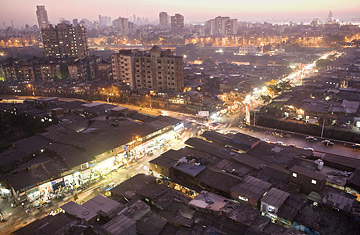
A view of a main intersection in Dharavi slum, with Mumbai city scape in background, in Mumbai, India
There's not much that the inhabitants of Dharavi can't recycle. Every day thousands of workers in India's most crowded slum--600,000 people squeezed into 500 acres (200 hectares) in the heart of Mumbai--shred plastic, mend clothes, strip computers, sort and bundle paper, fix machinery, flatten cardboard and clean and crush glass. The level of specialization is extraordinary. In the workshop of Abdul Salaam, two women use hammers to deftly pound the metal nibs out of the ends of dozens of plastic pen refills that they clutch like handfuls of fat spaghetti. Someone else will clean the refills, and a third group will shred the plastic into tiny granules that Salaam then sells for a profit of about $0.05 per lb. ($0.02 per kg). "New goods have very high rates," he explains over the relentless hammering. "There is profit in old stuff if you know how to find it."
Mumbai authorities apparently agree. The state government of Maharashtra, of which Mumbai (formerly Bombay) is the capital, wants to raze dozens of slums like Dharavi for redevelopment and new infrastructure as part of its multibillion-dollar plan to turn the city into a world-class financial center by 2015. No one doubts that India's business capital needs a makeover. Bad roads and inefficient or nonexistent public transport make getting around Mumbai a nightmare; monsoon rains and clogged rivers and drains regularly submerge whole sections of the city. In areas wet and dry, however, property prices are higher than those in midtown Manhattan. But the redevelopment plans will displace up to half the 14 million to 18 million people in India's largest city and challenge the idea that poor and rich can live side by side in a tumultuous democracy. Even the poorest in Mumbai agree that the city needs to change. But, they ask, at what cost?
Dharavi was created by a flood of humanity--thousands of poor immigrants crowded into Mumbai during the past century and built an incredible jumble of two- and three-story "hutments" constructed of concrete, corrugated tin and even cardboard. The tiny rooms--often as small as 100 sq. ft. (9 sq m)--can house more than a dozen people from two or three families at night and double as workplaces by day. Hundreds of people share common toilets and water supplies--the narrow walkways run with human waste. At the same time, Dharavi's entrepreneurial spirit not only produces millions of dollars in exports but also has created a vibrant community, one that happens to occupy some of the most expensive land in the world.
For decades, various government schemes to redevelop Dharavi and Mumbai's growing number of other slums have gone nowhere. Now the government says it is serious about change. Nineteen property developers, some of them huge non-Indian companies such as Emaar from Dubai and Hutchison Whampoa from Hong Kong, have expressed interest in a scheme that would transplant 50,000 families into new apartments with running water, flush toilets and communal centers. The successful bidders would be free to use the remaining land for their own projects, potentially worth billions, some of which would fund infrastructure work. "People should have a good living," says D.R. Hadadare, chief engineer of the Maharashtra Housing & Area Development Authority, who oversees the technical specifications of the scheme. "At the moment too many people don't have access to the basics."
But Mumbai's slum dwellers are suspicious that the plan is a way to force them out of the city. And they are not powerless. Despite government reassurances, they worry that the new seven-story apartment blocks will be built on the city's outskirts, far from where they work and where their kids go to school. Even if the new apartments--which the government promises will be a minimum of 225 sq. ft. (21 sq m) each--are built nearby, residents complain, operating factories seven floors up will be impossible. They are ground-level operators who require lots of interaction with other nearby factories and traders. "The idea is not improving the lot of Dharavi," says Jockin Arputham, the feisty president of the National Slum Dwellers Federation. "It's about how to make money out of Dharavi by selling the land."
Arputham says his supporters don't oppose the scheme in principle--"I totally agree with it; the policy is good"--but criticize its implementation, which he says unfairly favors developers. "Every living person in Dharavi wants development, but it should be people-centered, not money-centered," he said in his small, bare concrete office one recent evening. "They say they want a world-class city, but how can anybody on the earth create a world-class city without involving 60% of its people?"
One of the specific sticking points is a technical matter: the floor-space index (FSI), which measures building density. Many cities around the world have an FSI in the high single digits. New York City's average FSI is about 12; Mumbai's is just 1, one reason this huge city with so few tall buildings can be so expensive. The conundrum is that Mumbai could not cope with more tall buildings without massive improvements in its drains, roads and public transport. The government's slum plans offer developers an average FSI of 2.5. Arputham says this is proof that big companies will get the better bargain and wants more "incentives" for average people.
Still, the two sides seem to be creeping toward an understanding. Mumbai's masses may be poor, but they do vote, a fact that political parties have long banked on (and often cynically exploited) and that both Arputham and government officials are quick to note. "It is a participatory approach," says chief engineer Hadadare. "We want to talk, not to bulldoze them. That's democracy. I think it will work, and if it does, it can be a model."